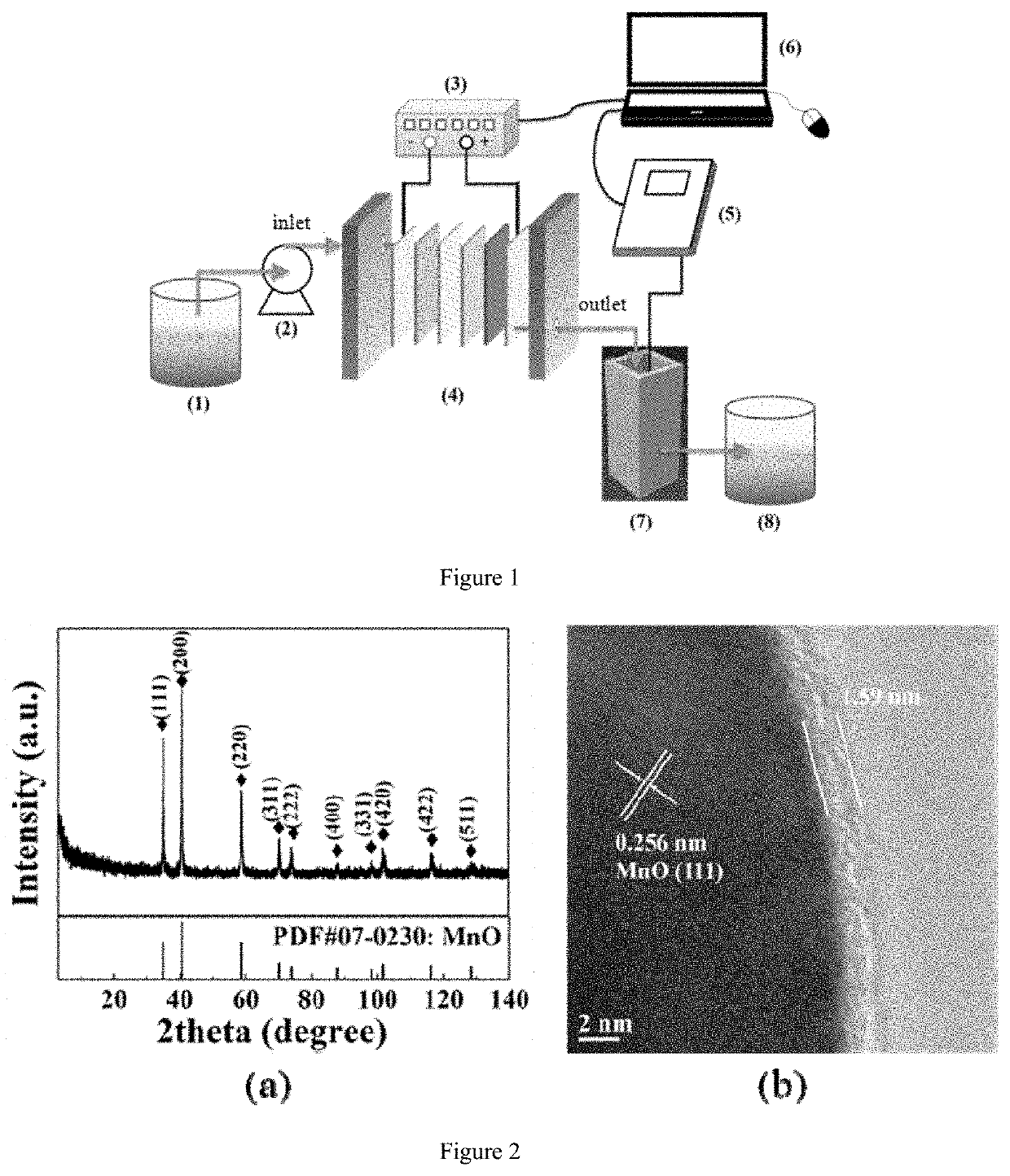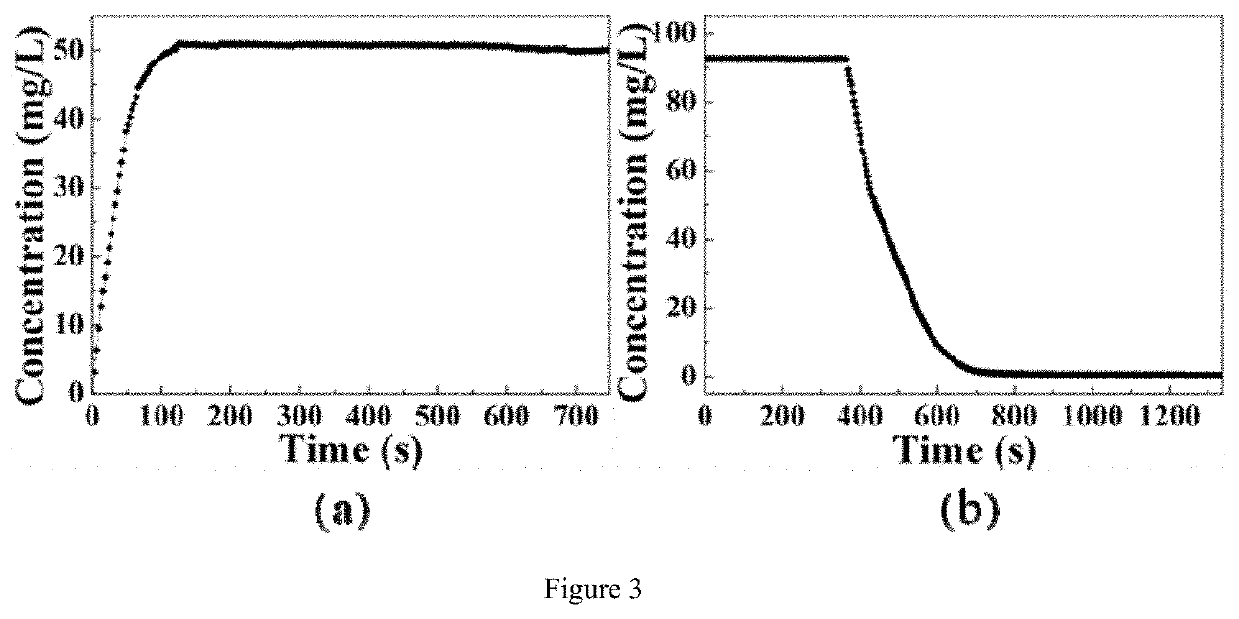Membrane electrode material, its preparation method and application in lithium extraction by adsorption-electrochemical coupling technology
a membrane electrode and electrode material technology, applied in the field of lithium resource separation and extraction, can solve the problems of affecting the separation and extraction of mg and li, affecting the new energy industry, nuclear energy, etc., and affecting the efficiency of the new energy industry
- Summary
- Abstract
- Description
- Claims
- Application Information
AI Technical Summary
Benefits of technology
Problems solved by technology
Method used
Image
Examples
example 1
[0023]A. Weighting and mixing 2.9556 g of Li2CO3 and 18.392 g of MnCO3 for calcination at 500° C. for 4 h with the heating rate of 3° C. / min; LiMn2O4 is prepared; 2.7 g of LiMn2O4 is further dispersed in hydrochloric acid solution (120 mL, 0.5 mol / L); after stirred for 24 h, the solid products can be separated and dried to obtain λ-MnO2;
[0024]B. Weighting 53 mL of DMF, 3.5 mL of ethanol and 3.5 mL of water to prepare the mixed solution. Weighing 2.198 g of MnCl2·4H2O and 0.6665 g of DHTA to dissolve them into the mixed solution to obtain the raw material solution of Mn-MOF-74.
[0025]C. Adding 1.5 g of λ-MnO2 in step A into the 60 mL of Mn-MOF-74 raw material solution prepared in step B; after uniform mixing, the solution is then transferred to the reactor, and the reaction is conducted at 80° C. for 2 h; upon cooling to room temperature, the suspension product is centrifuged and filtered; the filter product is washed with DMF solution for three times; at 40° C., after drying for 12 h...
example 2
[0032]A. Weighting and mixing 1.4778 g of Li2CO3 and 9.196 g of MnCO3 for calcination at 550° C. for 5 h with the heating rate of 4° C. / min; LiMn2O4 is prepared; 1.35 g of LiMn2O4 is further dispersed in hydrochloric acid solution (60 mL, 0.5 mol / L); after stirred for 26 h, the solid products can be separated and dried to obtain λ-MnO2;
[0033]B. Weighting 26.5 mL of DMF, 1.8 mL of ethanol and 1.8 mL of water to prepare the mixed solution. Weighing 1.099 g of MnCl2·4H2O and 0.333 g of DHTA to dissolve them into the mixed solution to obtain the raw material solution of Mn-MOF-74.
[0034]C. Adding 1.5 g of λ-MnO2 in step A into the 60 mL of Mn-MOF-74 raw material solution prepared in step B; after uniform mixing, the solution is then transferred to the reactor, and the reaction is conducted at 60° C. for 4 h; upon cooling to room temperature, the suspension product is centrifuged and filtered; the filter product is washed with DMF solution for three times; at 50° C., after drying for 10 h...
example 3
[0039]A. Weighting and mixing 5.9112 g of Li2CO3 and 36.784 g of MnCO3 for calcination at 600° C. for 6 h with the heating rate of 8° C. / min; LiMn2O4 is prepared; 5.4 g of LiMn2O4 is further dispersed in hydrochloric acid solution (240 mL, 0.5 mol / L); after stirred for 36 h, the solid products can be separated and dried to obtain λ-MnO2;
[0040]B. Weighting 106 mL of DMF, 7 mL of ethanol and 7 mL of water to prepare the mixed solution. Weighing 4.396 g of MnCl2·4H2O and 1.333 g of DHTA to dissolve them into the mixed solution to obtain the raw material solution of Mn-MOF-74.
[0041]C. Adding 1.5 g of λ-MnO2 in step A into the 60 mL of Mn-MOF-74 raw material solution prepared in step B; after uniform mixing, the solution is then transferred to the reactor, and the reaction is conducted at 40° C. for 6 h; upon cooling to room temperature, the suspension product is centrifuged and filtered; the filter product is washed with DMF solution for three times; at 60° C., after drying for 8 h, the...
PUM
| Property | Measurement | Unit |
|---|---|---|
| Temperature | aaaaa | aaaaa |
| Temperature | aaaaa | aaaaa |
| Temperature | aaaaa | aaaaa |
Abstract
Description
Claims
Application Information
 Login to View More
Login to View More - R&D
- Intellectual Property
- Life Sciences
- Materials
- Tech Scout
- Unparalleled Data Quality
- Higher Quality Content
- 60% Fewer Hallucinations
Browse by: Latest US Patents, China's latest patents, Technical Efficacy Thesaurus, Application Domain, Technology Topic, Popular Technical Reports.
© 2025 PatSnap. All rights reserved.Legal|Privacy policy|Modern Slavery Act Transparency Statement|Sitemap|About US| Contact US: help@patsnap.com


